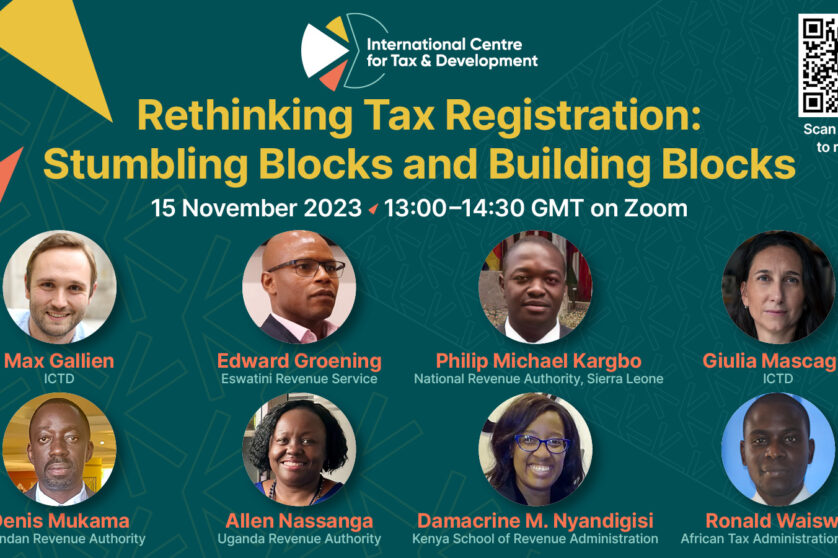Taxpayer registration has been a primary concern for revenue administrations. While these bodies have recently been investing significant efforts into registering a large number of new taxpayers in the broader quest to formalise the informal sector, these mass registration campaigns have presented new challenges, casting a doubt on their effectiveness.
Against this backdrop, the International Centre for Tax & Development (ICTD) held on Wednesday November 15 2023, a webinar on “Rethinking Tax Registration: Stumbling Blocks and Building Blocks” to explore the perspectives and experiences of five African tax practitioners on mass registration.
The webinar was moderated by, ICTD Research Director, Giulia Mascagni.
At the outset, ICTD Research Fellow, Max Gallien, introduced an ICTD policy brief that details the shortcomings of mass registration campaigns and highlights lessons learnt intended to enhance the registration process. Based on a number of different studies and experts’ discussions, the brief explains that mass registration campaigns are efficient only in the context of a broader process, which is often overlooked. It recommends registration efforts such as:
- targeting high income earners
- re-evaluating the goals of registration exercises
- rethinking the registration process by taking into consideration the context in which revenue authorities operate.
These views were echoed by Edward Groening from the Eswatini Revenue Authority who underscored the importance of overcoming administrations’ fixation with increasing the numbers of registered taxpayers and focusing instead on value and productivity. Groening described the specific challenges faced in Eswatini when applying mass registration campaigns and asserted that their marginal benefits are limited as practical costs exceeded collected revenue.
Similarly, Ronald Waiswa from the African Tax Administration Forum stressed that up to 70% of registers represent nonactive taxpayers. However, drawing on his own experience, Waiswa asserted that this problem is not specific to one country but rather concerns all African countries even developed ones like South Africa. Waiswa added that the primary obstacle for mass registration is the collection of unusable and misleading data which does not enable authorities to locate taxpayers and enforce tax collection, leading to a high number of unactive taxpayers.
The other panellists have summarised their position on mass registration in the following three blog contributions:
Damacrine M. Nyandigisi, Kenya School of Revenue Administration
Taxpayer registration is the primary building block of revenue collection; however, it is often overlooked by tax administrations. Indeed, these administrations have built an erroneous correlation between large number of taxpayers in the taxpayer register and higher revenue collection, this misconception has crippled the accuracy of the register by introducing “dirty data” to the database which consequently impedes compliance risk management processes.
The Organization for Economic Co-operation and Development (OECD) defines taxpayer registration as the process by which individuals, businesses, or other entities are officially recognised and documented by tax authorities for fulfilling their tax obligations (filing, payment, or accurate reporting). In other words, a taxpayer should ONLY be registered in the system for the purpose of filing or making a tax payment. Hence, mass registration could lead to: 1) The introduction of dormant and/or inactive taxpayers to the taxpayer register 2) An increase in the number of non and nil-filers 3) The imposition of penalties and interests to dormant and inactive taxpayers 4) An increase in inaccurate debt portfolio 5) Debt write offs 6) Inaccurate registers 7) Inefficient compliance risk programs 8) A decrease or stagnation in revenue collection.
An immediate shift from “mass registration” to “mass compliance risks analysis” is therefore needed. Indeed, tax administrations should focus on the analysis of data from different sources which can be facilitated through the usage of third-party data providers, namely associations that support the informal sector, counties/districts or sub nationals in charge of collecting license fees from businesses operating in this sector and finally, organisations in charge of business registrations. Compliance risk analysis will then flag the potential active taxpayers who should be required to register in the database.
These challenges are mostly faced by tax administration in developing countries who desperately need to increase their tax base to support their domestic resource mobilisation strategies. However, in order to achieve success in enhancing tax bases, we need first to reevaluate taxpayer registration and move away from the concept of “mass registration”.
Philip M. Kargbo, National Revenue Authority, Sierra Leone
Expansion of the tax base has been for years a priority for revenue administrations and has recently become even more popular with small and medium-sized enterprises (SMEs) being recognised for promoting fiscal governance accountability despite their relatively small revenue contribution. It is on this premise that Sierra Leone joined several other African countries in implementing what is commonly referred to as block management system (BMS). The BMS aims to increase block or mass registration by identifying informal businesses and understanding the practical challenges impeding registration with tax administrations. In 2021, the National Revenue Authority (NRA) launched a BMS pilot which involved identifying:
- existing businesses for registration into the new integrated tax administration system (ITAS)
- businesses yet to be registered with the NRA
- rented properties for registration with the NRA.
While the impact of such mass registrations can be a topic of debate, the process has its advantages. Evidence of success can be highlighted in Sierra Leone’s phase 1 mass registration experience. Indeed, in Sierra Leone the new tax register, through the ITAS, was easily expanded whether with new businesses or verified existing ones. Moreover, additional block registration offices were created to serve taxpayers. Similarly, mass registration raised awareness of SMEs’ obligation to register with the NRA in addition to local governments. Furthermore, by including the registration of rented properties, the process helped improve the rental income tax base through the identification of additional taxpayers as well as new properties and their respective addresses.
Perhaps most importantly, the initial phase of the BMS pilot, implemented in the Western area, provided key learning outcomes that will help enhance the next phase of the process and a nationwide rollout. Indeed, the mass registration faced notable challenges. These include resistance from businesses to be interviewed and registered, unprofessionalism of the enumerators, length of the ITAS registration form, inadequate taxpayer sensitisation to the exercise, limited coordination with business registration stakeholders, and pressure on enumerators to meet deadlines and targets.
These challenges, which might not be unique to Sierra Leone, could guide and facilitate the experience of other tax administrations intending to undertake a similar exercise.
Denis Mukama, Rwanda Revenue Authority
It is common knowledge within tax administrations that taxpayer registration is the foundation of administering taxes since it provides the database on who is required by law to register. That said, many tax administrations, especially those in developing countries, have approached taxpayer registration in a rather simplistic manner with the intention of merely growing the numbers. We see cases where, during the planning process, tax administrations set their performance measurement targets for the strategic objective of ‘widening the tax base’ on increasing their tax registers annually. However, this target does not take into consideration the quality of registration. In fact, it is usually after noticing large instances of inactivity (non-filing/payment – in some cases for over 60% of the total register) that these tax administrations resort to cleaning their registers.
However, a wind of change is blowing across tax administrations in developing countries as they embrace technology and data analytics within their operations. Technology and/or digitalisation of several tax administration functions has led to an abundant inflow of data. For example, since the Rwanda Revenue Authority (RRA) introduced in 2013, electronic invoicing systems, popularly known as “Electronic Billing Machines” (EBMs), the influx of transaction data grew exponentially. Such inflow, coupled with built capacity in data analytics and risk management, has enabled RRA to undertake targeted taxpayer registration. – How? One may ask. – Through matching these large data sets internally and with third party data sources (such as customs, land registry, and utility data) to identify large hidden players who had been operating outside the tax system even though they meet legal obligations. Large firm suppliers for instance have been forced to formalise since they were required to issue EBM invoices, and if they did not, the tax administration was able to locate and register them. RRA has therefore had to abandon the use of “bloc management system1” for mass registration. Instead, these blocs/offices are now used to expand RRA service offerings to business centres.
As these tax administrations continue to mature in stature and structure, improvements will be noted in data quality, the extent of integration with third party players, the quality of service delivery offerings, and ultimately in voluntary compliance levels.



